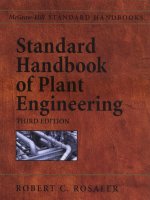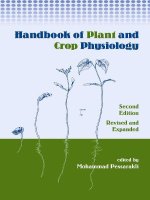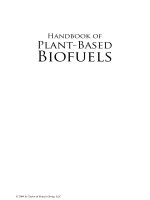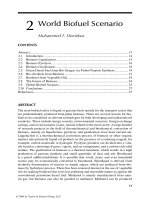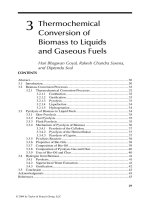Handbook of plant based biofuels - Chapter 17 doc
Bạn đang xem bản rút gọn của tài liệu. Xem và tải ngay bản đầy đủ của tài liệu tại đây (420.66 KB, 14 trang )
241
17
Biodiesel from
Rice Bran Oil
Yi-Hsu Ju and Andrea C. M. E. Rayat
ABSTRACT
There is a growing interest in the development and utilization of alternative fuels.
This is driven by several factors, which include environmental concerns regarding
the further use of petroleum fuels, energy security and independence, growth, and
commitment to international accords such as the Kyoto Protocol. Currently, the
widespread production and use of such alternative fuels as biodiesel is hindered by
its uncompetitive price against petroleum-based diesel fuel. The high cost of raw
material, usually rened vegetable oils, largely contributes to the expensive cost of
biodiesel. There is now an intensifying search for a cheaper raw material for biodiesel
production. One of these is rice bran oil. Rice, which is the staple food of more than
half of the world’s population, is produced at a rate of about 600 megatons per year.
Rice bran is a by-product of rice milling. Given the magnitude of annual rice produc-
tion, an enormous amount of bran is available. Unfortunately, bran is considered a
low-value material and mostly treated as an agricultural waste. This chapter shows
how oil from rice bran can be used as a feedstock for biodiesel production. Rice
bran also contains protein, and other important bioactive compounds, if harvested
from the bran, can be sold as high-value by-products. In this regard, this chapter also
CONTENTS
Abstract 241
17.1 Introduction 242
17.2 Rice Bran Oil Processing 243
17.3 RBO for Biodiesel Production 246
17.4 Technical Aspects of RBO Processing to Biodiesel 246
17.4.1 Extraction of RBO 247
17.4.2 Degumming and Dewaxing of Crude RBO 248
17.4.3 Acid-Catalyzed Biodiesel Production from RBO 248
17.4.4 Lipase-Catalyzed Biodiesel Production from RBO 249
17.4.5 In Situ Esterication/Transesterication 249
17.4.6 Choice of Alcohols for the Alcoholysis of RBO 250
17.5 Prospects of Biodiesel from RBO 251
17.6 Conclusions 253
References 253
© 2009 by Taylor & Francis Group, LLC
242 Handbook of Plant-Based Biofuels
highlights conditions for the retention and subsequent recovery of important bioac-
tive compounds in rice bran after biodiesel production. When integrated into the
process economics, the sale of these valuable co-products from rice bran processing
to biodiesel is one possible way of reducing the price of biodiesel.
17.1 INTRODUCTION
World annual rice production is about 600 million tons. More than 85% of this
comes from Asia, of which 90% is from China, India, Indonesia, Bangladesh, Viet-
nam, Thailand, Myanmar, and the Philippines. An increase in energy consumption
is expected in these countries. Such energy supply is normally in the form of petro-
leum oil. The importation of oil for energy uses up a country’s important nancial
reserves, which otherwise can be used to nance essential infrastructures. It is esti-
mated that Asian countries import about 60% of their requirement for oil. The reli-
ance on imported oil poses a threat to a country’s energy security.
The International Energy Agency (IEA) emphasizes the likelihood of better
living standards in developing countries with an increased access to energy ser-
vices. Reducing energy poverty is deemed as an urgent need to sustain a country’s
development. There is also the looming environmental damage that is reportedly
caused by the increasing use of energy. At least 30% of air pollution emissions are
attributed to the transport sector. In line with this is the global understanding to
reduce the cumulative emissions of greenhouse gases, as stipulated in the Kyoto
Protocol which was entered into force in February 2005. The protocol stipulates
that involved parties will have to reduce their overall emissions of greenhouse gases
by at least 5% below 1990 levels in the commitment period 2008 to 2012. As of
early 2006, there are 158 countries that ratied, accepted, or acceded to the Kyoto
Protocol. This international agreement has been one of the driving forces in the
search for and promotion and development of renewable energy and other innovative
environment-friendly technologies worldwide. Most developing countries in Asia are
parties to this protocol.
Thus, the search for alternative fuels is inevitable worldwide and so for the Asian
region. The development and utilization of alternative transport fuels is important
due to the prominent environmental concerns, and more precisely because of its
consequence for a country’s energy independence, growth, and international reputa-
tion. These alternative fuels should not only be technically plausible for application,
but should also be readily available, economically viable, environment friendly, and
should be produced preferably with sustainability. In this respect, biodiesel is being
developed and promoted as an alternative to petroleum diesel fuel. Biodiesel, which
is composed of monoalkyl esters of fatty acids, is receiving intensied interest as a
renewable fuel that is nontoxic and biodegradable. A major concern with this biofuel
is its high price. Without tax holidays or government subsidies, current biodiesel pro-
duction is economically unattractive. More research, development, and technological
advancements are still required with the current production. The cost of feedstock oil
contributes at least 70% to the biodiesel price. Hence, the use of inexpensive, noned-
ible feedstock and the recovery of high-value co-products during its production may
considerably lower the cost of biodiesel.
© 2009 by Taylor & Francis Group, LLC
Biodiesel from Rice Bran Oil 243
The prospect of producing biodiesel from rice bran, an underutilized by-product
from rice milling, is discussed in the succeeding sections. The annual world rice cul-
tivation yields an estimated 47 million tons of rice bran, from which about 9 million
tons of rice bran oil (RBO) could be available for the production of biodiesel. The
prospective biodiesel production from RBO in Asian countries is about 10 billion
liters. On average, this amounts to at least 10% of these countries’ diesel require-
ments. Figure 17.1 illustrates the potential biodiesel production against the estimated
diesel requirements for the world’s top ten rice producing countries.
17.2 RICE BRAN OIL PROCESSING
Rice is the staple food of about 55% of the world’s human population. It is grown in
most countries, with the largest production in Asia, where 135 million hectares of
rice area is cultivated. On a dry weight basis, the whole grain rice contains about 3%
embryo, 70% endosperm, 20% hull, and 8% rice bran. This composition differs to
some extent among rice varieties, and with specic cultivation methods and condi-
tions (Palipane and Swarnasiri 1985; Goffman, Pinson, and Bergman 2003). Rice
bran is obtained as a by-product of rice milling. It is particularly obtained during
the second stage of rice milling, after the rice has been dehulled. Typical composi-
tions of rice bran, its oil, and meal cake are presented in Table 17.1. Until recently,
rice bran has been used primarily as animal feeds. Only about 2 million metric tons
of bran are converted to oil annually. Thailand and Japan are the top exporting and
importing countries, respectively, of rened RBO. In 2003, Japan imported about
18,900 tons of rened RBO while the amount of rened RBO that Thailand exported
was roughly 18,800 tons.
At present, increasing interest is centered on the nutritive quality of RBO, which
has been reported to contain biologically active compounds and antioxidants such
as γ-oryzanol, fatty acid steryl esters, phytosterols, tocopherols, tocotrienols, leci-
thin (phospholipids), and wax esters. RBO has physicochemical properties that are
distinct from other edible oils and which render conventional vegetable oil rening
1
12345678910
10
100
1000
10000
100000
(
) Rice production [10
6
tons] ( ) Biodiesel potential from RBO [10
6
L]
(
) Estimated diesel requirement [10
6
L]
Country: (1) China; (2) India; (3) Indonesia; (4) Bangladesh; (5) Vietnam;
(6) ailand; (7) Myanmar; (8) Philippines; (9) Japan; (10) Brazil
FIGURE 17.1 Estimated biodiesel yield from rice bran oil among top rice-producing countries.
© 2009 by Taylor & Francis Group, LLC
244 Handbook of Plant-Based Biofuels
processes unsuitable. The high content of partial glycerides, polar lipids, and wax
esters in RBO makes its viscosity approximately two times that of other vegetable
oils. A considerable amount of gum is also present in crude RBO due to the unsatu-
rated nature of its fatty acids. Hence, the oil needs to be degummed and dewaxed
prior to rening. However, complete wax removal is often difcult. The residual wax
imparts haziness to the oil and is the main reason for the darker color of rened RBO
(Ju and Vali 2005). This dark color is the main cause of the low appeal of edible
RBO to consumers.
Another difculty encountered in the rening of crude RBO is caused by its high
free fatty acid (FFA) content. Crude RBO from fresh rice bran contains 6 to 8% FFA.
However, due to the presence of active enzymes in rice bran, FFA content of rice
bran during storage increases by 1 to 7% per day (Zullaikah et al. 2005). Depending
on the storage conditions, 35 to 70% FFA may be obtained in a month. It is pos-
sible to reduce this FFA increase by immediately extracting the oil from rice bran
right after milling. However, rice mills are often scattered in locations, thereby mak-
ing the collection of large quantities of fresh rice bran for immediate oil extraction
impractical. As a result, most crude RBO contains 40 to 50% FFA (Kosugi, Kuneida,
and Azuma 1994). Figure 17.2 illustrates a typical curve of FFA and triglycerides
(TG) content in rice bran under different storage conditions. It was reported that at
temperatures higher than 50°C, lipase activity is signicantly reduced, resulting in
less FFA formation in rice bran (Zullaikah et al. 2005).
Generally, it is not practical to rene crude RBO with FFA content higher than
10%. In particular, less than 5% FFA is desired for the cost-effective production
of rened RBO. The high FFA content also results in a large loss of neutral oil
because during rening, oil recovery is inversely proportional to the FFA content
TABLE 17.1
Typical Composition of Rice Bran, Meal Cake, and Oil
Rice Bran
(%, Wet Weight)
Rice Bran Meal Cake
(%, Dry Weight)
Water 9–12 Protein 14–16
Oil 15–27 Dietary ber 12–15
Crude protein 4–17 Phytic acid 5–9
Crude rice bran oil
a
(%, Dry Weight)
Triacylglycerides 60–86 Polar lipids 9–12
Partial glycerides 7–14 Sterols 3–5
Free fatty acids 2–8 Tocols 0.1–0.2
Waxes 1–4 T-Poryzanol or
γ-oryzanol
1–3
a
The free fatty acid (FFA) composition of crude rice bran oil may actually reach as much as 80%
depending on the storing age and condition of the rice bran.
Combined from Ignacio and Juliano (1968), Goffman, Pinson, and Bergman (2003), Juliano (1985),
Wang et al. (1999), Zullaikah et al. (2005), and Vali et al. (2005).
© 2009 by Taylor & Francis Group, LLC
Biodiesel from Rice Bran Oil 245
and the loss is normally two to three times the FFA content (Lai et al. 2005).
Therefore, inactivation of enzymes is important prior to oil extraction if rened
RBO is desired.
The process of enzyme inactivation, called bran stabilization, further increases
the product cost of rened oil. Furthermore, most bioactive compounds in crude
RBO are lost during rening. For example, as much as 90% of the oryzanol content
in crude RBO was lost during rening (Krishna et al. 2001). Recently, a process
employing simultaneous degumming and dewaxing in the physical rening of RBO
has been reported in which only a minimal oryzanol content (<10%) from the origi-
nal crude RBO was lost in the process (Rajam et al. 2005). However, about 20% of
the tocols was lost in the rening, although the amount left was still higher than
tocols content in commercially rened RBO. The process appears to be promising
but complete process analysis, including process economics, still needs to be estab-
lished. On the whole, processing of crude RBO into edible oil is not economically
attractive as of this moment.
Aside from processing into edible oil, other efforts are being made to harness
the nutrients in RBO. Some processes are currently being developed to recover and
purify the bioactive compounds such as γ-oryzanol (Xu and Godber 1999; Saska and
Rossiter 1998). Because the total bioactive compounds content of RBO is about 5%,
the direct recovery of these compounds from RBO will result in a complex proce-
dure with a lot of oil components as by-products. Indeed, acid oil or soap-stock from
crude oil rening comes out as the more suitable feedstock for oryzanol (3.3 to 7.4
w/w% on a dry basis) (Krishna et al. 2001).
Another process option, which is the main focus of this chapter, is to convert
the FFA and TG in RBO into fatty acid methyl esters (FAME), or biodiesel before
separating from it and purifying the remaining bioactive compounds.
Months
w/w %
FFA (1)
0
0
100
123456
TG (1) FFA (2)FFA (3)
FIGURE 17.2 Free fatty acid formation in rice bran during storage: (1) stored at 25°C; (2)
dried at 95°C under vacuum for 1 h and stored at 25°C; (3) stored at 5°C.
© 2009 by Taylor & Francis Group, LLC
246 Handbook of Plant-Based Biofuels
17.3 RBO FOR BIODIESEL PRODUCTION
The environmental and other benets of using biodiesel compared to petroleum die-
sel are well known. It is recognized, however, that the current expensive price of
biodiesel prevents the full utilization of such biofuel. The prices of oil feedstock and
by-product meal cake were cited as the two most important factors in the econom-
ics of biodiesel production (Ju and Vali 2005). In this respect, RBO is one of the
most valuable resources among the nonconventional oils investigated for biodiesel
production. Compared to traditional oils derived from cereal or seed sources, crude
RBO is an inexpensive feedstock for biofuel production. The current price of rice
bran in the United States is about US$55/ton. The price of degummed and dewaxed
RBO is estimated to be around US$0.18/lb (US$396/ton). This is about 40% cheaper
than the prices of rened vegetable oils, which are presently the feedstocks for com-
mercial biodiesel production. In other places, where there is less trade of rice bran,
the price may even be lower because the bran is normally considered as an agricul-
tural waste.
The high nutritional quality of soybean meal cake makes it possible to sell it at
higher market price than other meals. As a result, the price of biodiesel from soybean
is normally lower than that from other vegetable oils (Ju and Vali 2005). Like soybean
meal cake, defatted rice bran is a rich source of protein, other carbohydrates, and phy-
tochemicals, which have high commercial value. The essential amino acids prole in
rice bran protein isolate was found to be similar to that prescribed for children and
similar to that of soy protein isolate and casein (Wang et al. 1999). The lysine content
in rice bran protein is reportedly higher than in rice endosperm protein or any other
cereal bran proteins (Juliano 1985). Hence, rice bran meal cake has the potential of
gaining a high commercial market value like the meal cake of soybean. Furthermore,
crude rice bran wax is also available as a potentially important co-product. Vali et
al. (2005) reported the production of food-grade wax from degummed and dewaxed
crude RBO. The utilization of these co-products may signicantly lower the product
cost of biodiesel from RBO. Figure
17.3 illustrates a possible ow diagram for the
production of biodiesel and its co-products from rice bran.
17.4 TECHNICAL ASPECTS OF RBO PROCESSING TO BIODIESEL
The processing of RBO to biofuel appears to be less complicated than RBO rening.
In biofuel processing, there is relatively less concern with residual solvents than in
RBO rening. In addition, the presence of high initial amounts of FFA in RBO is
not problematic to the biodiesel process. Hence, RBO stabilization or special storage
infrastructure to minimize the increase of FFA in rice bran is not required. However,
certain considerations remain if an optimal recovery of different products in the pro-
cessing of RBO to biodiesel is desired. First, the choice of process conditions should
favor the retention of most bioactive compounds, which are mostly heat-sensitive
and may degrade at certain high temperatures (Zullaikah et al. 2005). Furthermore,
most of the bioactive compounds present in RBO are susceptible to alkaline treat-
ment due to their phenolic character. It was shown that treating RBO with a base
decreased the oryzanol content by as much as 90% and temperatures above 240°C
© 2009 by Taylor & Francis Group, LLC
Biodiesel from Rice Bran Oil 247
resulted in considerable loss of the tocols (Krishna et al. 2001). Second, it is desirable
to remove most, if not all, wax esters, phospholipids, and gums as these components
interfere with the conversion of RBO to biodiesel. It was reported that small amounts
of phospholipids resulted in the partial deactivation of lipase during the enzymatic
conversion of RBO to biodiesel (Lai et al. 2005). Hence, degumming and dewaxing
of crude RBO prior to further processing is essential. However, rening of crude
RBO is not required for biodiesel production because important minor components
with nutritional value may be lost during rening.
17.4.1 ex t r a c t i o n o f rBo
Solvent extraction is the most commonly used method in commercial oil extraction,
with hexane as the most widely used solvent. Commercial hexane, which contains
50 to 85% n-hexane and some isomers, has been cleared by the FDA as an extrac-
tion solvent. Hexane recoveries in commercial oil mills are usually higher than 96%.
There is no need to pelletize the bran prior to extraction. Rice bran in ake form
is enough to result in efcient extraction (Ju and Vali 2005). It is also possible to
recover RBO from rice bran by using supercritical carbon dioxide. However, such
Extraction
Meal Cake
Processing
Phytic
Acid
Hydrolysis
Crude Oil
Degumming/
Dewaxing
Rice
Bran Oil
Crude
Wax
Processing
Processing
Protein Isolate
Myo-inositol
Policosanol
Long Chain
Fatty Acids
Processing
RICE BRAN
BIODIESEL
BIOACTIVE
COMPOUNDS
Milling
Paddy or Rough Rice
Polished White Rice
Rice Hulls
Food Grade
Wax
Milling
Milling
FIGURE 17.3 Flow diagram of rice bran processing to biodiesel and co-products.
© 2009 by Taylor & Francis Group, LLC
248 Handbook of Plant-Based Biofuels
methods are often less economical than conventional hexane extraction and requires
further investigation to attain commercial viability.
17.4. 2 de G u m m i n G a n d de w a x i n G o f cr u d e rBo
The purpose of degumming and dewaxing is to remove fat-soluble impurities in the
oil. Dewaxing is especially required for RBO because of its high content of wax
esters. Degumming is usually done by adding polar solvents to the oil under ade-
quate mixing to allow polar lipids to be extracted into the polar phase. The mixture
is then cooled and centrifuged whereby wet gum is removed with the water phase.
Water degumming is the preferred method if minimal loss of bioactive compounds
is desired. It was found that a processing temperature of about 70°C and an addi-
tion of 4% water (based on the oil weight) was enough to substantially remove the
gums (Indira et al. 2000). A novel degumming process employed the use of 1% (v/w)
CaCl
2
solution, which achieved simultaneous degumming and dewaxing (Rajam et
al. 2005).
17.4. 3 ac i d -ca t a l y z e d Bi o d i e S e l Pr o d u c t i o n f r o m rBo
The acid-catalyzed conversion of RBO to fatty acid methyl esters (FAME) involves
two steps. FFA is rst transformed into FAME with water as the by-product. Some of
the acylglycerides may be converted during the rst phase of the reaction. However,
it has been shown that acid catalysis of acylglycerides is slow. To completely convert
the remaining acylglycerides, a second step in the conversion was proposed (Zullai-
kah et al. 2005). The water and glycerol produced during the rst step were removed
before subjecting the mixture to a second conversion step. The water-soluble compo-
nents were extracted by washing the mixture with water. In this extraction process,
methanol and catalyst were also removed. Another batch of acidic methanol was
added for the second conversion step of the remaining acylglycerides to FAME. The
amount of methanol added was four to six times the required stoichiometric amount
for the total conversion of acylglyceride. Methanol from the rst step can easily be
recovered by distillation and subsequently reused in the process.
Among acid catalysts that may be used are sulfuric acid, nitric acid, and hydro-
chloric acid. The esterication process may proceed using 1 to 5% (w/w, based on
oil) H
2
SO
4
, and about ve to six times the stoichiometric amount of methanol is
required for the total conversion of FFA. Sufcient agitation should be provided.
The temperature of the reaction is usually between 60 and 65°C. Although high-
temperature operation has its advantages, such conditions will incur relatively higher
expenses for the required high-pressure vessels.
The rst step normally takes about 2 h for the FFA content to drop below 5%,
while the second step may take 6 to 8 h to fully convert the remaining acylglyceride
to FAME. In a typical run, at the end of the rst step, the reaction mixture contains
about 3% FFA, 35% acylgycerides, and 62% FAME. At the end of the second step,
the FAME content in the product is more than 96% (Zullaikah et al. 2005).
Distillation may be employed for the separation of FAME from the reaction mix-
ture. However, since boiling points of FAME from RBO are generally higher than
300°C, atmospheric distillation is not recommended if the bioactive compounds are
© 2009 by Taylor & Francis Group, LLC
Biodiesel from Rice Bran Oil 249
to be recovered. Vacuum distillation with lower distillation temperature can be used.
Laboratory-scale vacuum (about 5 mmHg) distillation of the FAME up to 220°C
resulted in 99% pure FAME in the distillate (Zullaikah et al. 2005). The recovery of
FAME in the distillate was 96%. The residue contained about 18% γ-oryzanol and
20% mixture of sterols, steryl esters, and tocols.
17.4.4 li P a S e -ca t a l y z e d Bi o d i e S e l Pr o d u c t i o n f r o m rBo
The use of lipase (triacylglycerol acylhydrolyses, E.C. 3.1.1.3) to catalyze the reaction
of oils to FAME has been studied extensively. Lipases can catalyze the hydrolytic
reactions of acylglycerols and the synthetic reactions of their corresponding esters.
Some considerations of the lipase-catalyzed production of FAME include operation
under a certain (minimum) amount of water and not too high methanol concentra-
tion. It is detrimental to use too much excess methanol as opposed to alkaline- or
acid-catalyzed processes in producing biodiesel.
The lipase-catalyzed conversion of RBO to FAME is carried out in a two-step
reaction. This is because at a certain period after the start of the reaction, the water
and glycerol produced result in the deactivation of lipase (Lai et al. 2005). There-
fore, a second step is necessary, in which the enzyme in the rst step is reused after
regaining its activity, which results from incubating the enzyme in tert-butanol for
at least 1 h after washing with hexane. The preferred mode of addition of methanol
in the lipase-catalyzed production of biodiesel is the intermittent or repetitive batch
mode. A one-time addition of methanol leads to too high concentrations that the
lipase cannot tolerate. Sufcient mixing is also required. However, excess shear may
inactivate the enzyme.
After the rst-step and prior to the second step, the reaction mixture is washed
with water to extract water-soluble components. The second step of the enzymatic
process proceeds faster than that of the acid-catalyzed second-step reaction. The
lipase-catalyzed transesterication reduces the triacylglycerol content to about 2%
in 2 h and in about 3 h more than 98% FAME can be obtained in the product.
Since enzymatic processes are usually considered expensive, a biodiesel produc-
tion process from RBO may employ an acid-catalyzed reaction as the rst-step and
lipase-catalyzed reaction as the second step. In the second step, only a small amount
of enzyme is required because the amount of remaining triacylglycerol will be rela-
tively smaller compared to when the original RBO is subjected to lipase-catalyzed
reaction. Figure 17.4 illustrates a generic function diagram of biodiesel production
from rice bran.
17.4. 5 in si t u eS t e r i f i c a t i o n /tr a n S e S t e r i f i c at i o n
In the method described in the previous sections, the production of biodiesel started
from the extraction of oil from rice bran and subsequently using the oil for the con-
version of FFA and acylglycerides to FAME (biodiesel). Another method of produc-
ing biodiesel is using rice bran directly as the substrate for esterication without the
oil being extracted rst. Rice bran was subjected to a mixture of sulfuric acid (cata-
lyst) and methanol (Özgül-Yücel and Türkay 2002). Rice bran was prepared such
that the size was about 0.6 mm. Forty milliliters of methanol (with 2.5% v/v acid)
© 2009 by Taylor & Francis Group, LLC
250 Handbook of Plant-Based Biofuels
per gram rice bran were added to the bran. The acidied methanol was reuxed for
1 h at 65°C. After in situ reaction, the bran was ltered and the reaction mixture was
washed with methanol and water. Organic components in the mixture were extracted
with hexane. Although the process reduces the FFA content in the residual oil in the
bran better than the extraction process, FAME content by this method is quite lower
than the previously mentioned processes. Using rice bran with high FFA content
(approximately 75%), the FAME content only increased from 80% in 30 min to about
87% in 5 h. Adding more acid or methanol did not signicantly affect the methyl
esters content. In situ production of biodiesel from rice bran remains a challenge for
rice bran with low to medium FFA content.
The in situ process may be modied by incubating rice bran in acidied metha-
nol instead of having the reaction proceed in reuxed condition. Although not yet
reported in the case of RBO, this in situ process may yield more methyl esters than
the one previously described. Nevertheless, in situ transesterication of oil in oil-
seeds was still found to be less efcient than the normal process of transesterication
of oil (Haas et al. 2004). Improvement in this process still needs to be addressed,
especially with the large amount of methanol and catalyst used as compared to other
processes where oil reacts with methanol to form methyl esters.
17.4.6 cH o i c e o f al c o H o l S f o r t H e al c o H o l y S i S o f rBo
In a lipase-catalyzed process, it appears that methanol is the best among alcohols
tested, including ethanol, propanol, butanol, and isobutanol. However, it is recog-
nized that the optimal conditions for each alcohol in an enzymatic reaction may dif-
fer. It was also reported that branched alcohols may produce fatty acid alkyl esters
that have better fuel properties than FAME (Knothe 2005). However, the cheaper
price of methanol among the other alcohols remains the driving force behind its
more popular use.
Methanol
Recovery
FAME
TG, DG, MG
FFA
Crude
RBO
Degumming/
Dewaxing
Esterification
Vacuum
Distillation
Separation
Trans
Esterification
Water
Aqueous
Phase:
Methanol
Glycerol
Water
Catalyst
Methanol
Catalyst
D/D RBO
Methanol
Catalyst
Residue
(bioactive
compounds)
Methanol,
Catalyst, Water
FAME
(Biodiesel)
Catalyst
Recovery
Glycerol
Recovery
Bioactive
Compounds
Recovery
FIGURE 17.4 Function diagram of biodiesel production from rice bran oil.
© 2009 by Taylor & Francis Group, LLC
Biodiesel from Rice Bran Oil 251
17.5 PROSPECTS OF BIODIESEL FROM RBO
The basic properties of fatty acids and FAME from RBO are provided in Tables 17.2
and 17.3. The World-Wide Fuel Charter (WWFC), which is made by association
members of international car and engine manufacturers, provides technical back-
ground on fuel properties. The WWFC acknowledges that FAME ensures lubricity
of injection equipment and reduces exhaust particulate matter. The excessive rise in
viscosity and the loss of uidity at low temperatures were observed for some FAME.
This seems not to be the case for FAME from RBO because RBO contains a high
percentage of unsaturated fatty acids (more than 70% are oleic and linoleic acids). It
was reported that feedstocks with relatively low content of saturated long chain fatty
acids generally yield biodiesel with lower cloud point (CP) and pour point (PP) (Dunn
2005). CP is the temperature at which crystals become visible, while the temperature
at which excessive crystal formation prevents free pouring of the uid is the PP. The
lower the CP and PP, the better is the fuel’s performance at cold temperatures.
Other important properties include cetane number (CN), density, and viscosity.
A high CN results in less hydrocarbon and CO emissions, and reduces fuel consump-
tion and combustion noise. The CN generally increases with increasing chain length
and decreases with increasing unsaturation. It has been reported that higher CN cor-
relates with lower nitrogen oxides (NO
x
) exhaust emission (Knothe 2005). An inspec-
tion of the CN of the constituent FAME from RBO reveals that these FAMEs have,
on average, a cetane rating above 40. Most biodiesel from plant sources, including
soybean and rapeseed oil, have CN higher than 47. The minimum CN of biodiesel
for automotives is 47 (ASTM D6751) or 51 (European biodiesel standard, EN 14214)
TABLE 17.2
Fatty Acids of Degummed and Dewaxed Rice Bran Oil
Common
Name of Fatty
Acid %
a
Chemical
Formula
Melting
Point
b
(°C)
Boiling
Point
c
(°C)
Density
d
(g/cm
3
)
Myristic 0.1–0.3 C
14
H
28
O
2
53.9 250
100
0.8622
54
Palmitic 14.2–15.2 C
16
H
32
O
2
63.1 351.5 0.8527
62
Palmitoleic 0.1–0.4 C
16
H
30
O
2
-0.1 131
0.06
Stearic 1.6–2.1 C
18
H
36
O
2
68.8 232
15
0.9408
20
Oleic 41.5–42.9 C
18
H
34
O
2
13.4 286
100
Linoleic 37.3–38.3 C
18
H
32
O
2
-12 229-30
16
0.9022
20
Linolenic 2.2–2.5 C
18
H
30
O
2
-11 231
17
129
0.05
0.9164
20
Behenic 0.1–0.3 C
22
H
44
O
2
81 306
60
0.8223
90
Lignoceric 0.1–0.4 C
24
H
48
O
2
a
Degummed and dewaxed rice bran oil. Data from Zullaikah et al. (2005).
b
Data from Lide (2002).
c
Data from Lide (2002). The superscript is the pressure in mmHg at which the boiling point was
measured.
d
Data from Lide (2002). The superscript is the temperature in °C at which the density was measured.
© 2009 by Taylor & Francis Group, LLC
252 Handbook of Plant-Based Biofuels
(Knothe, Van Gerpen, and Krahl 2005). It is, therefore, presumed that biodiesel from
RBO, given its component FAME, will also have a CN greater than or about 47.
As mentioned above, the use of FAME improves the lubricity of petroleum diesel
fuel. Most developed countries require low or even zero sulfur in petroleum diesel
fuels. During the process of desulfurization, nonsulfur polar compounds are also
removed (Knothe 2005). These compounds are reported to be responsible for the
lubricity in petroleum diesel fuels. Hence, the lubricity of such fuels is negatively
affected after desulfurization. In this aspect, biodiesel has an advantage over petro-
leum diesel because biodiesel from plant sources has natural components that impart
sufcient fuel lubricity.
Biofuel from plant sources may contain antioxidants that can augment the oxi-
dative stability of the fuel. The oxidative stability of biodiesel is important during
extended storage (Knothe 2005). The presence of air, elevated temperatures, and
trace metals have been reported to aid the oxidation process. Further, the degree of
unsaturation of fatty esters has large effects on the autoxidation of FAME. Linoleic
and linolenic acids and their esters are generally more susceptible to autoxidation
(Knothe 2005). RBO, like soybean oil and rapeseed oil, contains large amounts of
oleic and linoleic acids. This would seem to be a disadvantage as the oxidation pro-
cess will result in the deterioration of biofuel. However, it was shown recently that
crude palm oil methyl esters that contained about 644 ppm vitamin E (a mixture of
tocols) and 711 ppm β-carotene showed better oxidative stability than distilled palm
oil methyl esters, which barely contained such antioxidants (Liang et al. 2006). It was
shown that about 0.1% α-tocopherol in biodiesel was enough to meet the required
specication of the EN 14214 in terms of oxidative stability. Note that RBO contains
about 0.2% of these potent natural antioxidants. With proper process design, distilled
RBO biodiesel may have the required or even better oxidative stability if sufcient
amounts of these antioxidants are retained.
TABLE 17.3
Properties of Fatty Acid Methyl Esters (FAME) From Rice Bran Oil
Methyl Ester of
Chemical
Formula
Melting
Point
a
(°C)
Boiling
Point
b
(°C) Density
c
Viscosity
d
(cSt)
Cetane
Number
e
Myristic acid C
15
H
30
O
2
19 295, 155
7
0.8671
20
3.23 66.2
Palmitic acid C
17
H
34
O
2
30 417, 148
2
0.8247
75
4.32–4.38 74.5
Stearic acid C
19
H
38
O
2
39.1 443, 215
15
0.8498
40
5.51 86.9
Oleic acid C
19
H
36
O
2
-20 218.5
20
4.45–4.51 55–59.3
Linoleic acid C
19
H
34
O
2
-35 215
20
0.8886
10
38.2–42.2
Linolenic acid C
19
H
32
O
2
182
3
0.8960
25
Behenic acid C
23
H
46
O
2
54
a
Data from Lide (2002).
b
Data from Lide (2002). The numbers in parenthesis are the pressures (in mmHg) at which the
measurements were made.
c
Data from Lide (2002). The superscript is the temperature in °C at which the density was measured.
d
Data from Knothe (2005).
e
Data from Knothe (2005).
© 2009 by Taylor & Francis Group, LLC
Biodiesel from Rice Bran Oil 253
17.6 CONCLUSIONS
It is recognized that the nutritive value of rice bran is due to the presence of bioac-
tive compounds in the oil. One way to benet from this is to process rice bran oil to
rened oil for human consumption. However, there are issues in the rening of rice
bran oil. This chapter presented such issues and showed an alternative way to obtain
nutritive bioactive compounds in rice bran. This alternative is the production of biod-
iesel from rice bran oil. Oil from rice bran makes a good feedstock for biodiesel
production. Because rice bran is generally regarded as an agricultural waste, it is a
potential cheap raw material for producing inexpensive biodiesel. Based on a survey
of the literature, it was shown that the process of producing biodiesel from rice bran
oil can be carried out in such a way that these bioactive compounds are retained.
Specically, these conditions include the use of an acid instead of a base catalyst to
avoid damaging the bioactive compounds, and low-temperature (vacuum distilla-
tion) purication of biodiesel because some bioactive compounds are heat labile. The
recovery of these bioactive compounds occurs during the purication of biodiesel.
With proper process design, these compounds can be recovered as co-products with
puried biodiesel. If the recovery and sale of these high-value bioactive compounds
is integrated in the process economics of biodiesel production from rice bran oil,
then the price of biodiesel from rice bran oil may potentially be cheaper than the
price of petro-diesel.
REFERENCES
Dunn, R. O. 2005. Cold weather properties and performance of biodiesel. In The Biodiesel
Handbook. Champaign, IL: AOCS Press, pp. 83–121.
Goffman, F. D., S. Pinson, and C. Bergman. 2003. Genetic diversity for lipid content and fatty
acid prole in rice bran. J. Am. Oil Chem. Soc. 80(5): 485–490.
Haas, M. J., K. M. Scott, W. N. Marmer, and T. A. Foglia. 2004. In situ alkaline transesteri-
cation: An effective method for the production of fatty acid esters from vegetable oils.
J. Am. Oil Chem. Soc. 81(1): 83–89.
Ignacio, C. C. and B. O. Juliano. 1968. Physicochemical properties of brown rice from Oryza
species and hybrids. J. Agric. Food Chem. 16(1): 125–127.
Indira, T. N., J. Hemavathy, S. Khatoon, A. G. G. Krishna, and S. Bhattacharya. 2000. Water
degumming of rice bran oil: A response surface approach. J. Food Eng. 43: 83–90.
Ju, Y. H. and S. R. Vali. 2005. Rice bran oil as a potential resource for biodiesel: A review. J.
Sci. Ind. Res. 64: 866–882.
Juliano, B. O. 1985. Rice bran. In Rice Chemistry and Technology. St. Paul, MN: American
Association of Cereal Chemists, pp. 647–687.
Knothe, G. 2005. Dependence of biodiesel fuel properties on the structure of fatty acid alkyl
esters. Fuel Process Technol. 86: 1059–1070.
Knothe, G., J. Von Gerpen, and J. Krahl (eds.). 2005. The Biodiesel Handbook. Champaign,
IL: AOCS Press.
Kosugi, Y., T. Kuneida, and N. Azuma. 1994. Continual conversion of free fatty acids in rice
bran oil to triacylglycerol by immobilized lipase. J. Am. Oil Chem. Soc. 71: 445–448.
Krishna, A. G. G., S. Khatoon, P. M. Shiela, C. V. Sarmnadal, T. N. Indira, and A. Mishra.
2001. Effect of rening crude rice bran oil on the retention of oryzanol in the rened
oil. J. Am. Oil Chem. Soc. 78(2): 127–131.
© 2009 by Taylor & Francis Group, LLC
254 Handbook of Plant-Based Biofuels
Lai, C. C., S. Zullaikah, S. R. Vali, and Y. H. Ju. 2005. Lipase-catalyzed production of biod-
iesel from rice bran oil. J. Chem. Technol. Biotechnol. 80: 331–337.
Liang, Y. C., C. Y. May, C. S. Foon, M. A. Ngan, C. C. Hock, and Y. Basiron. 2006. The
effect of natural synthetic antioxidants on the oxidative stability of palm diesel. Fuel
85: 867–870.
Lide, D. R. (ed.). 2002. Handbook of Chemistry and Physics, 83rd ed. Boca Raton, FL:
CRC Press.
Özgül-Yücel, S. and S. Türkay. 2002. Variables affecting the yields of methyl esters derived
from in situ esterication of rice bran oil. J. Am. Oil Chem. Soc. 79(6): 611–614.
Palipane, K. B. and C. D. P. Swarnasiri. 1985. Composition of raw and parboiled rice bran
from common Sri Lankan varieties and from different types of rice mills. J. Agric.
Food Chem. 33: 732–734.
Rajam, L., D. R. S. Kumar, A. Sundaresan, and C. Arumughan. 2005. A novel process for
physically rening rice bran oil through simultaneous degumming and dewaxing. J.
Am. Oil Chem. Soc. 82(3): 213–220.
Saska, M. and G. J. Rossiter. 1998. Recovery of γ-oryzanol from rice bran oil with silica-
based continuous chromatography. J. Am. Oil Chem. Soc. 75(10): 1421–1427.
Vali, R., Y. H. Ju, T. N. B. Kaimal, and Y. T. Chern. 2005. Process for preparation of food
grade rice bran wax and determination of its composition. J. Am. Oil Chem. Soc. 82(1):
57–64.
Wang, M., N. S. Hettiarachchy, M. Qi, W. Burks, and T. Siebenmorgen. 1999. Preparation and
functional properties of rice bran protein isolate. J. Agric. Food Chem. 47: 411–416.
Xu, Z. and S. Godber. 1999. Purication and identication of component of γ-oryzanol in rice
bran oil. J. Agric. Food Chem. 47: 2724–2728.
Zullaikah, S., C C. Lai, S. R. Vali, and Y. H. Ju. 2005. A two-step acid-catalyzed process for
the production of biodiesel from rice bran oil. Bioresource Technol. 96: 1889–1896.
© 2009 by Taylor & Francis Group, LLC


